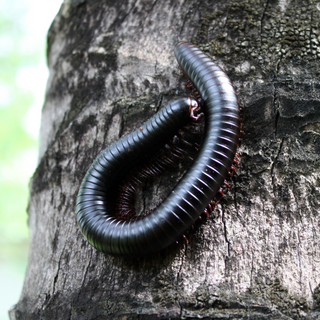Latin name: Diplopoda
Millipedes belong to the myriapod invertebrate group. As a myriapod, millipedes have segmented bodies, many legs, antennae, and breathing holes called spiracles. Unlike centipedes, millipedes have two pairs of legs per body segment. They are in the class Diplopoda. 'Di' means two and 'pod' means feet – two feet per segment. Millipedes have an exoskeleton, meaning outer skeleton, like a shell.
Although the name millipede means 1000-footed, no millipede was known to have 1000 legs until 2021. In that year a millipede found in Western Australia belonging to the species Eumillipes persephone, was found to have a total of 1306 legs! This is more than any other animal on earth.
The body of a millipede is divided into two parts - the head and the trunk.
The head of a millipede has eyes, antennae and chewing mouthparts. The trunk of a millipede is made up of rounded segments, or ‘body rings’. Each body ring, except for a few behind the head and one or more at the tail end, has two pairs of legs attached to it.
Many species of millipede have ‘ozopores’ along the sides of their body rings. These ozopores produced toxic chemicals which defend against predators or other threatening animals. These chemicals are not toxic to humans but may leave a stain.
SOLUTIONS:
- Contact: Apparent Surround
Reference: Millipedes - Field of Mars Environmental Education Centre (nsw.gov.au)


